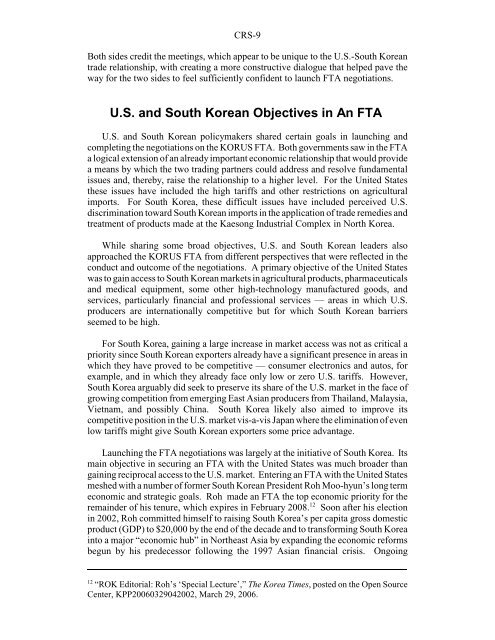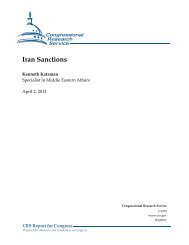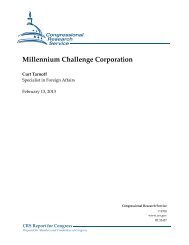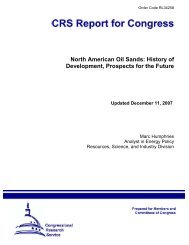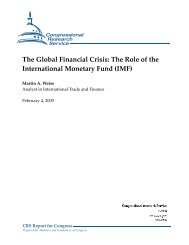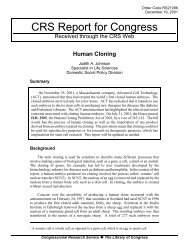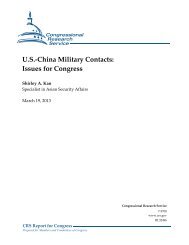The Proposed U.S.-South Korea Free Trade Agreement (KORUS ...
The Proposed U.S.-South Korea Free Trade Agreement (KORUS ...
The Proposed U.S.-South Korea Free Trade Agreement (KORUS ...
- TAGS
- korea
- fpc.state.gov
Create successful ePaper yourself
Turn your PDF publications into a flip-book with our unique Google optimized e-Paper software.
CRS-9<br />
Both sides credit the meetings, which appear to be unique to the U.S.-<strong>South</strong> <strong>Korea</strong>n<br />
trade relationship, with creating a more constructive dialogue that helped pave the<br />
way for the two sides to feel sufficiently confident to launch FTA negotiations.<br />
U.S. and <strong>South</strong> <strong>Korea</strong>n Objectives in An FTA<br />
U.S. and <strong>South</strong> <strong>Korea</strong>n policymakers shared certain goals in launching and<br />
completing the negotiations on the <strong>KORUS</strong> FTA. Both governments saw in the FTA<br />
a logical extension of an already important economic relationship that would provide<br />
a means by which the two trading partners could address and resolve fundamental<br />
issues and, thereby, raise the relationship to a higher level. For the United States<br />
these issues have included the high tariffs and other restrictions on agricultural<br />
imports. For <strong>South</strong> <strong>Korea</strong>, these difficult issues have included perceived U.S.<br />
discrimination toward <strong>South</strong> <strong>Korea</strong>n imports in the application of trade remedies and<br />
treatment of products made at the Kaesong Industrial Complex in North <strong>Korea</strong>.<br />
While sharing some broad objectives, U.S. and <strong>South</strong> <strong>Korea</strong>n leaders also<br />
approached the <strong>KORUS</strong> FTA from different perspectives that were reflected in the<br />
conduct and outcome of the negotiations. A primary objective of the United States<br />
was to gain access to <strong>South</strong> <strong>Korea</strong>n markets in agricultural products, pharmaceuticals<br />
and medical equipment, some other high-technology manufactured goods, and<br />
services, particularly financial and professional services — areas in which U.S.<br />
producers are internationally competitive but for which <strong>South</strong> <strong>Korea</strong>n barriers<br />
seemed to be high.<br />
For <strong>South</strong> <strong>Korea</strong>, gaining a large increase in market access was not as critical a<br />
priority since <strong>South</strong> <strong>Korea</strong>n exporters already have a significant presence in areas in<br />
which they have proved to be competitive — consumer electronics and autos, for<br />
example, and in which they already face only low or zero U.S. tariffs. However,<br />
<strong>South</strong> <strong>Korea</strong> arguably did seek to preserve its share of the U.S. market in the face of<br />
growing competition from emerging East Asian producers from Thailand, Malaysia,<br />
Vietnam, and possibly China. <strong>South</strong> <strong>Korea</strong> likely also aimed to improve its<br />
competitive position in the U.S. market vis-a-vis Japan where the elimination of even<br />
low tariffs might give <strong>South</strong> <strong>Korea</strong>n exporters some price advantage.<br />
Launching the FTA negotiations was largely at the initiative of <strong>South</strong> <strong>Korea</strong>. Its<br />
main objective in securing an FTA with the United States was much broader than<br />
gaining reciprocal access to the U.S. market. Entering an FTA with the United States<br />
meshed with a number of former <strong>South</strong> <strong>Korea</strong>n President Roh Moo-hyun’s long term<br />
economic and strategic goals. Roh made an FTA the top economic priority for the<br />
remainder of his tenure, which expires in February 2008. 12 Soon after his election<br />
in 2002, Roh committed himself to raising <strong>South</strong> <strong>Korea</strong>’s per capita gross domestic<br />
product (GDP) to $20,000 by the end of the decade and to transforming <strong>South</strong> <strong>Korea</strong><br />
into a major “economic hub” in Northeast Asia by expanding the economic reforms<br />
begun by his predecessor following the 1997 Asian financial crisis. Ongoing<br />
12 “ROK Editorial: Roh’s ‘Special Lecture’,” <strong>The</strong> <strong>Korea</strong> Times, posted on the Open Source<br />
Center, KPP20060329042002, March 29, 2006.


